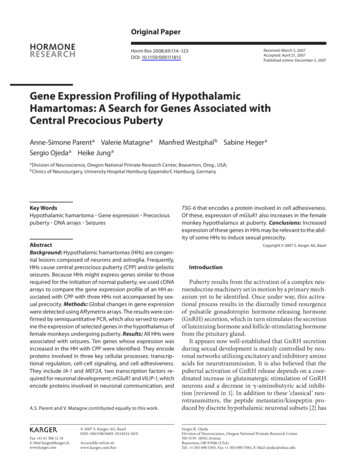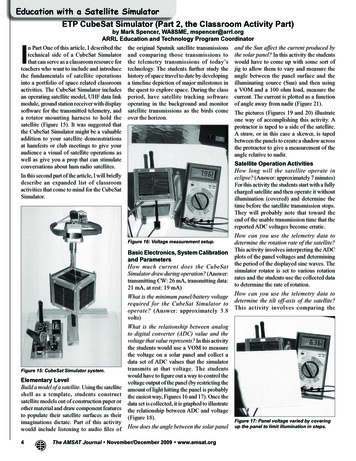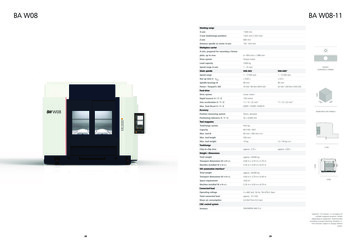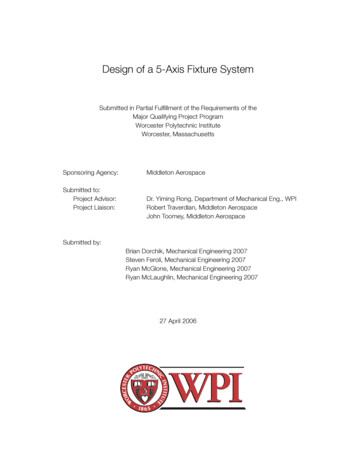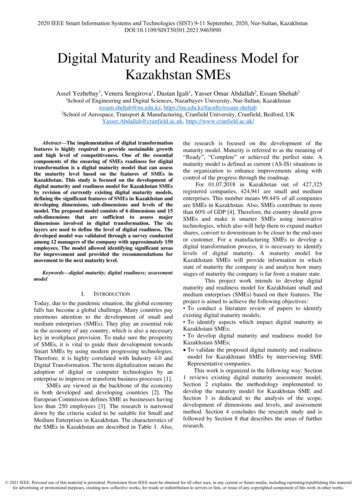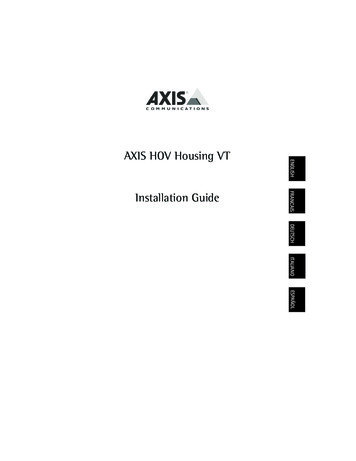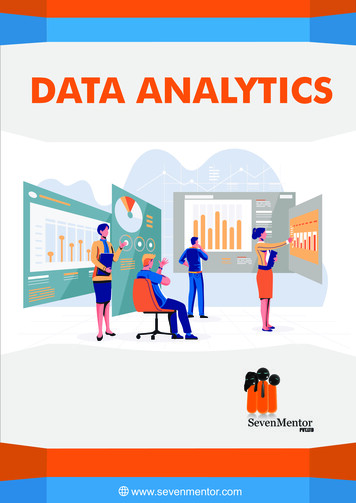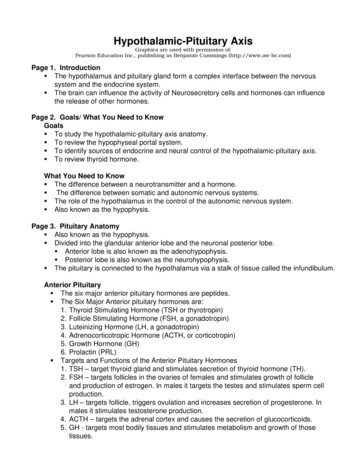
Transcription
Hypothalamic-Pituitary AxisGraphics are used with permission of:Pearson Education Inc., publishing as Benjamin Cummings (http://www.aw-bc.com)Page 1. Introduction The hypothalamus and pituitary gland form a complex interface between the nervoussystem and the endocrine system. The brain can influence the activity of Neurosecretory cells and hormones can influencethe release of other hormones.Page 2. Goals/ What You Need to KnowGoals To study the hypothalamic-pituitary axis anatomy. To review the hypophyseal portal system. To identify sources of endocrine and neural control of the hypothalamic-pituitary axis. To review thyroid hormone.What You Need to Know The difference between a neurotransmitter and a hormone. The difference between somatic and autonomic nervous systems. The role of the hypothalamus in the control of the autonomic nervous system. Also known as the hypophysis.Page 3. Pituitary Anatomy Also known as the hypophysis. Divided into the glandular anterior lobe and the neuronal posterior lobe. Anterior lobe is also known as the adenohypophysis. Posterior lobe is also known as the neurohypophysis. The pituitary is connected to the hypothalamus via a stalk of tissue called the infundibulum.Anterior Pituitary The six major anterior pituitary hormones are peptides. The Six Major Anterior pituitary hormones are:1. Thyroid Stimulating Hormone (TSH or thyrotropin)2. Follicle Stimulating Hormone (FSH, a gonadotropin)3. Luteinizing Hormone (LH, a gonadotropin)4. Adrenocorticotropic Hormone (ACTH, or corticotropin)5. Growth Hormone (GH)6. Prolactin (PRL) Targets and Functions of the Anterior Pituitary Hormones1. TSH – target thyroid gland and stimulates secretion of thyroid hormone (TH).2. FSH – targets follicles in the ovaries of females and stimulates growth of follicleand production of estrogen. In males it targets the testes and stimulates sperm cellproduction.3. LH – targets follicle, triggers ovulation and increases secretion of progesterone. Inmales it stimulates testosterone production.4. ACTH – targets the adrenal cortex and causes the secretion of glucocorticoids.5. GH - targets most bodily tissues and stimulates metabolism and growth of thosetissues.
6. PRL - targets the breasts in females. Stimulates breast development and lactation. Of the six anterior pituitary hormones, four directly stimulate other endocrine glands andare known as tropic hormones. For each target gland/tissue here fill in the correct anterior pituitary hormone. Also make sure to highlight the four tropic hormones. The anterior pituitary gland is connected to the hypothalamus via the hypophyseal portalsystem.Capillaries in the ventral hypothalamus pick up hormones released by hypothalamicneurons and transport them to the capillaries of the anterior pituitary.Posterior Pituitary Is composed primarily of neuronal tissue. Is connected to the supraoptic and paraventricular nuclei of the hypothalamus via axonsin the infundibulum. Stores two major neurohormones for later release.1. ADH (vasopressin) – stimulates water reabsorption by kidneys.2. Oxytocin – stimulates labor contractions during birth. Release of posterior pituitary and hypothalamic hormones is identical to neurotransmitterrelease by other neurons. Molecules that function as hormones in the hypothalamic-pituitary axis are oftenneurotransmitters, neuromodulators, or paracrines in other places in the body.**Now is a good time to go to the quiz questions #1&2. Click the quiz button on the left side of the screen. Click on the scrolling page list at the top of the screen and complete questions 1&2. When you are finished you can click the return from link button on the left side of thescreen to return to the topic.
Page 4. Hypothalamic Hormones Are the first in a series of hormones that ultimately leads to the secretion of hormones byspecific endocrine glands. Several of the hypothalamic hormones stimulate tropic hormones in the anterior pituitary. Observe the following diagram closely to see how hypothalamic hormones influence theregulation of secretions of other endocrine glands. For each hormone series, negative feedback loops control circulating levels of the targetgland hormones.Negative feedback from the target gland can be directed at the anterior pituitary, theventral hypothalamus or both.TRHTSHTHCRHACTHCortisol
The hypothalamic hormones also maintain the anterior pituitary and the tropic hormoneshelp to maintain their target endocrine glands.In some instances hormones of one series will cause the secretion of the hormones ofanother series (i.e. TH stimulates secretion of GH).Prolactin (PRL) is unique because its primary stimulus from the hypothalamus is inhibitoryexcept after birth when milk production begins.**Now is a good time to go to the quiz questions #3 &4. Click the quiz button on the left side of the screen. Click on the scrolling page list at the top of the screen and complete questions 3 &4. When you are finished you can click the return from link button on the left side of thescreen to return to the topic.Page 5. Hypothalamus, Autonomic Nervous System, and Neuroendocrine interactions Parts of the cerebral cortex, limbic system, basal nuclei, reticular formation, and retina allproject to the thalamus. Strong emotions, ingestion of food, painful stimuli, trauma, infection, hot/cold extremes,and light input from the retina can influence the endocrine system through thesehypothalamic circuits. There are several examples of how the hypothalamus mediates endocrine responses.1. Neuroendocrine reflexes Suckling or crying can initiate the milk letdown reflex. Sensory input oxytocin mammary glands milk letdown.2. Chemically sensitive neurons. Osmoreceptors in hypothalamus are stimulated by high concentrations of solute inthe blood. This leads to synthesis and release of ADH. ADH targets the kidneys and promotes the reabsorption of water.3. Circadian rhythms Some hormones exhibit daily fluctuations. Input form the retina onto the hypothalamus is one way in which day/nighthormones levels fluctuate. Cortisol has pronounced high and low peaks throughout the day.**Now is a good time to go to the quiz question #6. Click the quiz button on the left side of the screen. Click on the scrolling page list at the top of the screen and complete question 6. When you are finished you can click the return from link button on the left side of thescreen to return to the topic.Page 6. Thyroid Hormone Review Be sure to view all the steps in the animations on this page and make notes in thespaces provided below. All of these concepts have been covered in other topics.
Secretion Transport Cellular Mechanism of Action Synthesis Functions BreakdownPage 7. Hypothyroidism and Hyperthyroidism Diseases of the thyroid gland are common. When viewing the symptoms of hyposecretion or hypersecretion keep in mind themetabolic effects that TH has on its target tissues. Listed below are common symptoms of both hyposecretion and hypersecretion of TH.
Chronic hyposecretion can lead to myxedema.Chronic hypersecretion can be caused by tumors or an autoimmune disease known asGrave’s disease.Diseases of the thyroid can be primary or secondary in nature Primary disease is one in which the gland itself is affected. Secondary Disease is when the anterior pituitary or the hypothalamus is notfunctioning properly.Primary hypothyroidism can be caused by:1. Failure of thyroid gland to secrete TH.2. Lack of dietary iodine leads to insufficient TH production.Secondary hypothyroidism can be caused by:1. A lack of TSH or TRH due to pathology.Primary hyperthyroidism can be caused by:1. Tumor of thyroid gland.2. Grave’s disease.Secondary Hyperthyroidism can be caused by:1. Excess secretion of the anterior pituitary or hypothalamus.Keep in mind when reviewing this page that excesses of hypothalamic and pituitaryhormones will have positive effect on thyroid gland and cause it to enlarge. A lack of
hypothalamic or pituitary hormones will have negative effect on the size of the thyroidgland.**Now is a good time to go to the quiz question #5. Click the quiz button on the left side of the screen. Click on the scrolling page list at the top of the screen and complete question 5. When you are finished you can click the return from link button on the left side of thescreen to return to the topic.Page 8.Summary Hypothalamic neurons produce hormones. Some hypothalamic hormones enter the systemic circulation from the posterior pituitarygland and others influence the anterior pituitary via the hypophyseal portal system. TSH, FSH, LH, ACTH, and GH from the anterior pituitary influence secretion of a thirdhormone from a target gland (tropic effects). Target gland hormones can exert negative feedback control of the hypothalamus and/oranterior pituitary. Neurons throughout the brain influence the hypothalamus. All about thyroid hormone, and the causes and consequences of hypo- andhypersecretion of TH.Notes on Quiz QuestionsQuiz Question #1: Pituitary Anatomy and Hormones. The first part of this question has you label the parts of the hypothalamus and pituitarygland. The second part of this question requires you to place the posterior pituitary hormoneswhere they are produced. The third part of this question requires you to place the six anterior pituitary hormones onthe diagram where they are produced. The fourth part of this question requires you to identify the two inhibiting hypothalamichormones. The final part of this question requires you to place the hypothalamic hormones at theircorrect sites of production.Quiz Question #2: Hypothalamic and Pituitary Hormones The first part of this question requires you select eight hormones that are secreted directlyinto the systemic circulation by either the hypothalamus or the pituitary gland. The second part of this question requires you to identify the hypophyseal portal veins.Quiz Question #3: Cortisol and Negative Feedback This question requires you to use your knowledge of the negative feedback loop betweenCRH ACTH Cortisol. You will be given a clinical problem and you must predict the results of the clinical teststhat were administered.Quiz Question #4: Prolactin and Inhibition This question deals with the unique relationship between prolactin and dopamine.
Remember that under normal circumstances prolactin secretion is inhibited.Quiz Question #5: Hypothyroidism This question presents you with a clinical problem dealing with primary hypothyroidism. Keep in mind that a primary disease is one in which the endocrine gland is not workingproperly. Use your knowledge of negative feedback to predict what will happen withtreatment.Quiz Question #6: Circadian Rhythms This question requires you to choose which events will upset the circadian rhythm. Remember that your circadian rhythm is set by light/dark cycles.Study Questions on Endocrine System Review1. (Page 3.) Label this figureSupraoptic nucleiParaventricular nucleiVentral nucleiAnterior pituitaryPosterior pituitary2. (Page 3.)What is the name of the specialized capillary system that connects the ventralhypothalamus to the anterior pituitary?3. (Page 3.)Match the following hypothalamic hormones with their functions:TRHCRHGNRHDAADHGHRHa. Inhibits production of prolactinb. Stimulates secretion of FSH and LHc. Triggers secretion of TSH
d. Stimulates the secretion of GHe. Promotes water reabsorption by the kidneysf.Causes the secretion of ACTH4. (Page 3.)What is a tropic hormone?5. (Page 3.)What are the major tropic hormones of the anterior pituitary and what are theirtargets?6. (Page 4.)High levels of cortisol due to injections of cortisone will have what effect on thesecretion of CRH and ACTH?7. (Page 4.)Lack of TSH would lead to a in TH.8. (Page 4.)Why is secretion of PRL unique amongst hormones of the hypothalamic-pituitaryaxis?9. (Page 4.)In general hormones of the hypothalamic-pituitary axis are maintained by amechanism.10. (Page 5.)Which of the following would not influence the endocrine system via thehypothalamus?a. strong emotionsb. bright lightsc. painful stimulid. infectionse. all of the above would influence the endocrine system via the hypothalamus11. (Page 5.)Hormones such as cortisol exhibit daily fluctuations that are part of our bodiesnormal .12. (Page 6.)What are the main ingredients necessary for TH synthesis?13. (Page 6.)True or False: TH binds with plasma membrane receptors.14. (Page 6.)List several of the main functions of TH.15. (Page 7.)Mental sluggishness can be a symptom of .16. (Page 7.)Grave’s disease is usually a primary/secondary disease of the thyroid gland.17. (Page 7.)Excessive secretions of TSH from the anterior pituitary can lead to.
1. ADH (vasopressin) - stimulates water reabsorption by kidneys. 2. Oxytocin - stimulates labor contractions during birth. Release of posterior pituitary and hypothalamic hormones is identical to neurotransmitter release by other neurons. Molecules that function as hormones in the hypothalamic-pituitary axis are often


